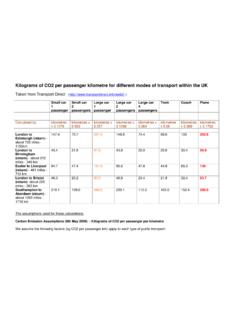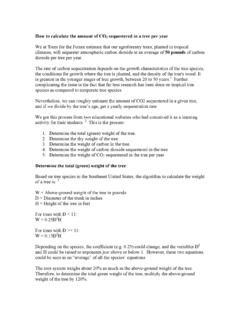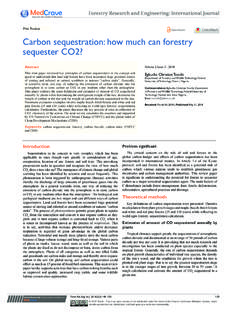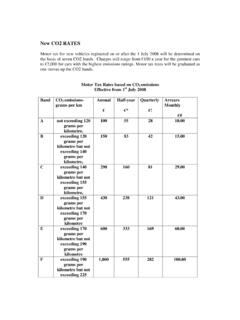Transcription of Brite Tank carbonation basics - New Mexico State University
1 Brite Tank carbonation basics carbonation is the dissolving of gaseous carbon dioxide (CO2) in an aqueous solution (in this case, beer.) carbonation is governed by Henry's Law, which states: At a constant temperature, the amount of a given gas that dissolves in a given type and volume of liquid is directly proportional to the partial pressure of that gas in equilibrium with that liquid. Or, in other words, the solubility of a gas in a liquid is directly proportional to the partial pressure of the gas above the liquid. This is the science behind natural carbonation . As the pressure above the beer increases (in a bottle, cask or tank) some of the CO2 is dissolved into beer.
2 Carbonating a full batch of beer with a carbonating stone in a Brite tank provides for much quicker carbonation . The carbonating stone increases the surface area contact with the beer by producing tiny bubbles of CO2, which are more easily absorbed into the beer. Before carbonating your beer, it is important to know the temperature of your beer and your target carbonation level. The lower the temperature of the beer, the more easily CO2 is dissolved into the beer. Ideally, you want your beer between 30 and 32 degrees Fahrenheit, although it should not be an issue if your beer temperature is as high as 38 or 40F. The carbonation level or amount of CO2 in solution of beer is most often expressed in terms of volumes of CO2.
3 This is a measure of the volume or space the gas would occupy at atmospheric pressure and 0 degrees Celsius if it were removed from the beer. For instance, if all of the CO2 were removed from one liter of a typical American ale at volumes and expanded at 0 C, its volume would be liters. Different styles of beer are carbonated to different levels, and draft beer is typically packaged with lower carbonation levels than bottled beer. Once you know the temperature of your beer and your target carbonation level, you can download a carbonation chart like the one on the last page of this document. This chart with give you a rough idea of the pressure required to achieve the desired volumes of CO2 at a given temperature at equilibrium.
4 Find the temperature of your beer on the left axis of the chart and then read across until you find the desired volumes of CO2, then follow the column up to see at what pressure that level of carbonation is achieved*. You will know your beer is at equilibrium when the head pressure (as measured by the pressure gauge on the tank) is equal to the pressure being added via the carbonation stone and no more gas is dissolving into the beer. Before carbonating your first batch, you need to know the wetting pressure of your carbonation stone. This is the amount of pressure required for CO2 to push through the pores of the stone and begin making tiny bubbles.
5 Each stone will have a different wetting pressure. To determine your wetting pressure, attach CO2 to the stone and put it in a bucket of water or sanitizer. Set it in sideways, as that is the orientation it will be in when carbonating your beer. Turn the pressure up slowly until a nice curtain of bubbles rises. Record that pressure. That is your wetting pressure. It is usually somewhere between 2-8 psi. There is also hydrostatic pressure exerted on the stone by the beer in the tank. Every 28 inches of liquid exert 1 pound of pressure on the stone. So, measure from your carbonation stone to the liquid level on your sight glass to get the hydrostatic pressure.
6 Chances are you are starting with completely flat beer. The first step is to get it into the Brite tank and make sure it is chilled. If you had already chilled the beer in the fermenter, simply transfer the beer to the Brite (making sure you first purge the tank with CO2). If your beer is not chilled, make sure it is chilled before you begin carbonating. If you filter your beer, you normally do that as you transfer the chilled beer from the fermenter into the Brite tank. Let's say you are brewing a standard American ale (pale, IPA, porter, etc.) and you want about volumes of CO2 in the beer. Check the temperature of your beer (if you have no thermowell in the Brite tank, draw off a small sample from the sample port and check the temperature).
7 From your carbonation chart, the vertical axis is your temperature. Find the temperature of your beer, then run across horizontally until you find your desired volumes of CO2. For example, at 35 degrees F volumes are achieved at 10 psi. So, when the head pressure, as measured by the pressure gauge on top of the tank reaches equilibrium at 10 psi, your beer should be carbonated to volumes of CO2. To reach that level, you want to go slowly, otherwise you run the risk of CO2 scrubbing , which reduces your head retention and blows off a lot of your volatile aroma components. nd Stout tanks and Kettles, LLC | 16300 SW 72 Ave.
8 , Portland, OR 97224 | 503-372-9580. Brite Tank carbonation basics One method for knowing when your tank has reached equilibrium is to install a rotometer or inline gas flow meter between your regulator and your carbonation stone. When the flow through the stone stops or slows to a very slow trickle, your tank should be at or near equilibrium. There are several methods used for reaching that pressure. We will focus on two: Starting with 0 head pressure and slowly building to your target pressure; and Starting with head pressure of 1 psi below your target saturation pressure. With both methods, it can be desirable to start with your carbonation stone pressure slightly higher than the head pressure and slowly bleed off some gas from the top of the tank.
9 This can scrub any dissolved air that made its way into the beer during transfer to the Brite tank. Be careful not to overdo this or it can lead to foaming in the tank, which will scrub desirable aroma components and adversely affect head retention. In the first method, you start by setting your regulator on the carbonation stone line at about 2-3 psi over your wetting pressure. This will also account for the liquid pressure on the stone. Start with a very low psi and gradually increase the pressure every half- hour to hour until you reach your final pressure, which would be the sum of the wetting pressure + liquid pressure + target pressure.
10 For example, if to reach your target volumes of CO2, the chart says you need 10 psi and you know your wetting pressure is 3 and you have 53 inches of beer in your tank (about 2 pounds of pressure), your final pressure through the stone would be 10+3+2= 15 psi. Once you reach 15 psi, start watching your pressure gauge. When it stabilizes at 10 psi, you should have beer carbonated to volumes of CO2. This can take anywhere from hours to more than a day, depending on the temperature of your beer and any residual carbonation left from fermentation. The rationale for starting with 0 head pressure is that you can start with a lower pressure through your carbonation stone and avoid any foaming, which would scrub aromatics and damage head retention.





